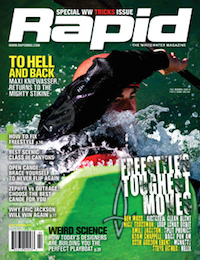At its roots, the term freestyle is pretty self-explanatory. You are free to do whatever you want, expressing your style however you want. Freestyle kayaking is no exception; paddlers invent new moves on waves and in holes, and add personal flair to existing maneuvers.
Unfortunately, when it comes to scoring freestyle competitions, freedom and style could not be further from judges’ minds. To do well in competition, paddlers are forced to check their style in the eddy and conform to the definitions in a rulebook.
The system rewards speed over execution, assigning the same point value to a move whether it is performed perfectly or sloppily. This often leads to poor form and makes competitions less appealing for spectators. The loss of spectators, and competitors, is the single biggest hurdle facing freestyle kayaking competitions today.
This shouldn’t come as a shock to anyone who’s attended a freestyle event lately. Competitor turnout at freestyle events around the globe has dwindled tenfold in the past decade. The senior men’s class at the World Championships dropped from 131 participants in 2003 to just 70 in 2007 (the 2009 Worlds drew a more encouraging 103).
“Numbers are down at the big events, especially in the pro classes,” multi-time U.S. Free- style Team member and pro circuit competitor Bryan Kirk says. “Although participation seems to be increasing at new amateur events like the World Kayak Hometown Throwdown series, I’m not sure it will ever equal what it was in 2000.”
Decreasing kayak sales, waning sponsorship dollars and a slew of less-than-ideal event venues contributed to this decline, but competition format has played a critical role. Since its incep- tion, the freestyle scoring sheet has changed almost every year, making it hard for competitors to keep track of how they’re judged, and nearly impossible for spectators to keep track of who’s winning.
Fixing the scoring system could help solve the attendance problem. But the change needs to happen at a fundamental level. Simply putting a number value on each move just doesn’t work for freestyle kayaking. The current bonus points for amplitude and trick combinations are not enough.
“The problem with the scoring system is that it produces a big gap between the top paddlers, who can do every trick both ways, and the average competitors,” says Jeremy Laucks, OC1 World Champion and long-time pro tour judge. “The hard tricks are worth so much more…that if you don’t have them wired, you’re not competitive. For a lot of competitors, that’s discouraging.”
A NEW SYSTEM NEEDED
A new system needs to be devised that will reward competitors for flawless execution, style and creativity. Nearly every sport that celebrates the same free and style roots as kayaking is judged subjectively: half pipe snowboarding, freestyle skiing, skateboarding, bmx, figure skating, even baton twirling. A skater is not awarded a set number of points for merely landing her triple axel, regardless of how it is executed. So why is a kayaker?
Adopting a system like this would give athletes a rubric that stands the test of time, no matter how many new moves are invented or how drastically boat designs evolve. More importantly, it would bring freedom and style to competition, and with it the paddlers who are the lifeblood of the sport.
Kelsey Thompson is a four-time member of the Canadian Freestyle Kayak Team and the current national champion.
 This article first appeared in the Early Summer 2011 issue of Rapid Magazine. For more great content, subscribe to Rapid’s print and digital editions here.
This article first appeared in the Early Summer 2011 issue of Rapid Magazine. For more great content, subscribe to Rapid’s print and digital editions here.



